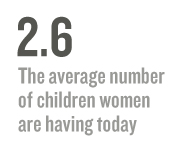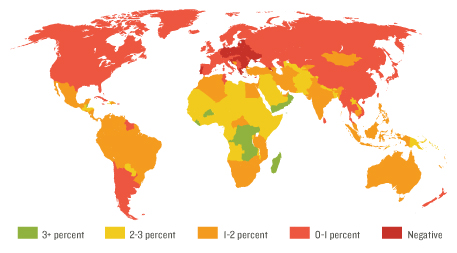March 24, 2013 — Two German shepherds kept as pets in Europe or the U.S. use more resources in a year than the average person living in Bangladesh. The world’s richest 500 million people produce half of global carbon dioxide emissions, while the poorest 3 billion emit just 7 percent. Industrial tree cutting is now responsible for the majority of the 13 million hectares of forest lost to fire or the blade each year — surpassing the smaller-scale footprints of subsistence farmers who leave behind long, narrow swaths of cleared land, so-called fish bones.
In fact, urban population growth and agricultural exports drive deforestation more than overall population growth, according to research from geographer Ruth DeFries of Columbia University and her colleagues. In other words, the increasing urbanization of the developing world — as well as an ongoing increase in consumption in the developed world for products that have an impact on forests, whether furniture, shoe leather or chicken fed on soy meal — is driving deforestation, rather than containing it as populations leave rural areas to concentrate in booming megalopolises.
The combination of increasing health, empowered women and falling birth rates may be the most important revolution to come out of the tumultuous 20th century.
So are the world’s environmental ills really a result of the burgeoning number of humans on the planet — growing by more than 150 people a minute and predicted by the United Nations to reach at least 9 billion people by 2050? Or are they more due to the fact that, while human population doubled in the past 50 years, we increased our use of resources fourfold?
Peak Humanity
 First and foremost, human population growth peaked long ago, according to demographer Joel Cohen of Rockefeller University in New York and others. The peak growth rate — a little more than 2 percent per year — occurred somewhere between 1965 and 1970, when the world’s population was just 3.3 billion people, and has been dropping ever since, reaching a little over 1 percent today. In 1987, the number of people added to the planet each year topped out at 87 million, a number that is now down to roughly 78 million people per year. That means human population numbers will drop voluntarily for the first time ever in human history in the 21st century. A Baby Bust has replaced the Baby Boom.
First and foremost, human population growth peaked long ago, according to demographer Joel Cohen of Rockefeller University in New York and others. The peak growth rate — a little more than 2 percent per year — occurred somewhere between 1965 and 1970, when the world’s population was just 3.3 billion people, and has been dropping ever since, reaching a little over 1 percent today. In 1987, the number of people added to the planet each year topped out at 87 million, a number that is now down to roughly 78 million people per year. That means human population numbers will drop voluntarily for the first time ever in human history in the 21st century. A Baby Bust has replaced the Baby Boom.
The reason? Empowerment of women. A massive reduction in child mortality, combined with educated mothers pursuing their own advancement and in control of birth control, has helped to drop the average human brood from over five children per woman of childbearing age to just 2.6 per woman today. As journalist Fred Pearce writes in his new book, The Coming Population Crash: “The population bomb is being defused. By women. Because they want to.”
In fact, the combination of increasing health (especially a greater proportion of babies surviving to adulthood), empowered women and falling birth rates may be the most important revolution to come out of the tumultuous 20th century. Those of us born between 1930 and 2050 will be among the privileged few to have ever witnessed a doubling of global population. It took from the dawn of humanity to the 19th century to achieve 1 billion people on the planet — an achievement that now comes roughly every few decades. And the 21st century will likely belong to the old, as elders outnumber youth for the first (recorded) time in human history: Fewer than 10 percent of people alive today are under 4 years old, while those 60 and older now constitute more than 10 percent of the population. Birth rates in countries such as Germany have fallen so far that populations are already shrinking.

POPULATION GROWTH RATE (2011) Births, deaths, immigration and emigration — all influenced by health, nutrition, education, prosperity and more — create different patterns of population change in different places. Source: World Bank.
Yet this demographic transition does not hold everywhere. While family planning has proven effective in the past in countries ranging from Thailand to Iran, funding for such programs has dwindled in recent years. Partially as a result, developing countries in eastern Africa — Kenya, Tanzania, Uganda and Zimbabwe — have seen populations begin to swell again in recent years.
Capacity Unknown
The real question is, how many people can the planet sustain? As Cohen notes in his book How Many People Can the Earth Support?, microbiologist Anton van Leeuwenhoek calculated a carrying capacity of roughly 13.4 billion people back in 1679, based on the population density of his native Holland and its size relative to the rest of the globe. Modern guesses are hardly more scientific, ranging from as few as 1 billion (recently proposed by James Lovelock as our likely number by 2100 thanks to catastrophic climate change) to as many as 1 trillion.
Ensia shares solutions-focused stories free of charge through our online magazine and partner media. That means audiences around the world have ready access to stories that can — and do — help them shape a better future. If you value our work, please show your support today.
Yes, I'll support Ensia!

But what many advocates of lower consumption don’t realize is that the U.S. population is both consuming at an unsustainable pace and also growing at a historically pace unprecedented in the developed world.
In contrast, the countries of the European Union, which in 1980 had a combined population twice the size of the 225 million recorded in the 1980 U.S. Census, has grown by a modest 10% since then. The U.S., meanwhile, has grown by 40% in the same time frame, adding 90 million people to the largest and most wasteful society on the planet.
This pace is expected to continue even without the increases proposed by immigration reform, but the White House just released a “Fact Sheet” which claims that ““U.S. population growth is projected to fall almost in half over the next three decades.”
http://www.uspolicy.be/headline/white-house-fact-sheet-economics-immigration-reform
This is a dubious statement based on percentage of a rapidly growing whole, but it is flat-out false in regards to numerical growth, which reflects more accurately the climate impacts and the failures to maintain our infrastructure in keeping with this expansion.
For a more detailed analysis in video and text form, see
www.onethirdorunder.org
Global replacement rate is 2.33 children per woman.
USA = 2.4, UK = 1.7, Aus = 1.76 (2000-05), so telling people to "take responsibility" is really pointing the finger at the third world.
Claiming 'education' is the solution & presenting rich educated Indian girls wanting one child as evidence is ingenuine. Since only the well off can afford education, that evidence rather points to the effect of material security on family size.
Large families provide the only security the poor can achieve, risky as that strategy is for them. But their desperate need for security questions how the first world exploits the third world to provide the standard of living WE demand.
India uses 1.3ha of the earth / person - we use between 3 & 4 times that, but sustainability (and justice!) demands we reduce that to 2ha. It is more pleasant to focus on their ignorance, isn't it.
We should demolish the fraud being committed - we haven't got time to be going down wrong paths blaming the poor for the state of the planet or its future!
Selling an idea is often about telling enough truth to slip in the lie unnoticed from which you can profit.
Just thought I needed to say something.
Regrds
Chris Baulman
@landrights4all
earth's sustainability and our cooling population growth rate doesn't fix the damage caused by the influence we have on raising everyone else's footprint by bad example.
And how is it possible to not mention production since that too has been universally recognized as critical since the 1950. The personal act of consuming does not in and of itself have any environmental impact. Chomping down on on a burger doesn't kill a wolf. It is the production of cows that kills wolves. So while politically engaged enviromentalists have linked population, consumption and production for over 60 years, de-political pundits like to ignore production and focus on a fairly meaningless pseudo "debate" about consumption vs. population.
It's time we put false dichotomies and debates aside and focus on all three pillars of the human impact simultaneously.
Kieran Suckling
Center for Biological Diversity.
The fact that wealthier nations are generally nearer to replacement rate than poorer countries does not mean that all calls for "taking responsibility" are secretly aimed at poor nations. The impact of any nation is Population x Consumption x Production. Wealthier nations may have lower fertility levels, but they have higher consumption rates and, for many products, more damaging production systems. From this perspective, the U.S. is on the most overpopulated countries on earth. Thus not surprisingly, people are working on these issues in both wealthy and poorer countries. In the U.S., for example, 40% of all pregnancies are unplanned and access to family planning is under assault by reactionary state policies. There is much work to be done here, and many population, reproductive rights and human rights groups trying to improve things in the U.S.
It is well established that increased education, increased freedom and rights, and increased access to birth control--especially for women--is very effective at reducing fertility rates, improving economic conditions and increasing freedom from gender oppression. This is not just a matter of the high level of education you seem to be referring to that is largely out of reach to poor people. Better education and gender equality are possible for and relevant to all people, regardless of their economic situation. There are many groups and nations working on both in very poor communities with very limited education systems.
Kieran Suckling
Executive Director
Center for Biological Diversity
USA is locked into consumerism - that is the problem.
It's also ridiculous to refer to unwanted pregnancies in the context of the sustainability of a population size. The population of USA is growing because of immigration, not pregnancies - pregnancy is happening at lower than relacement rates, wanted or not! The problem is consumerism & the example it sets for the rest of the world. Until we name the real demon we will continue to look for solutions in the wrong places.
Education is upheld as the way forward, but it has led to consumerism because of the system it operates in & upholds. Women know where babies come from - they don't need education for that. To choose to have smaller families they need other ways to security than a big family - no, not education in consumerism - just their RIGHTFUL access to a SECURE place to be.
In the capitalist model, this involves education to be able to compete successfully enough to buy a home - and that requires compliance with the consumer economy. Why? Because "the system" has stolen our birthright to land & we can only get secure access again by conforming.
That evil requirement to conform to consumerism is at the root of our environmental issues & many of our social issues too.
Technology won't save us from greed - it has always been used to increase consumption. Get solar cars & there will be more production of cars - & highways etc etc.
There is another way - a more attractive way for the vast majority who are looking for a way to escape poverty. But "overpopulationists" have their eyes firmly shut & ears plugged.